1 of 16
Download to read offline
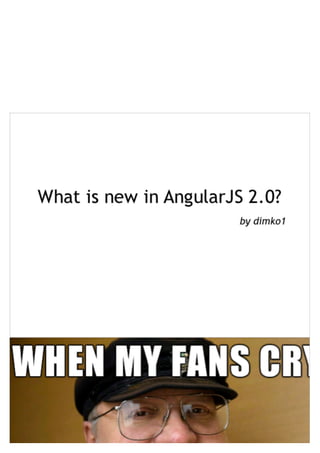

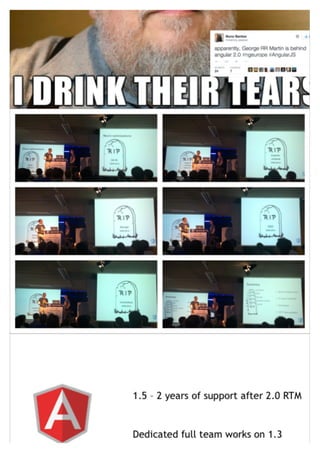


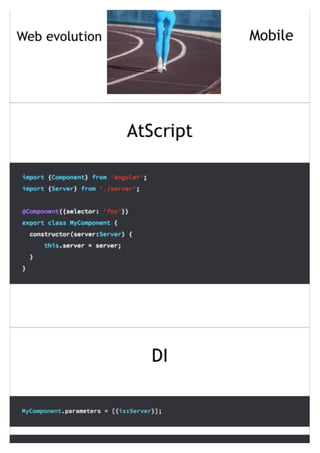
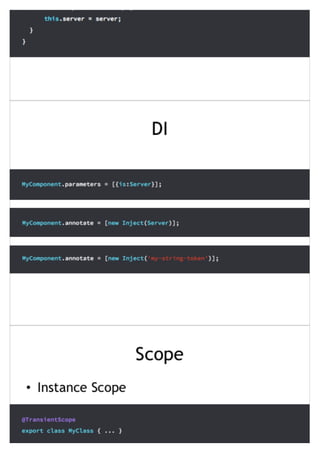
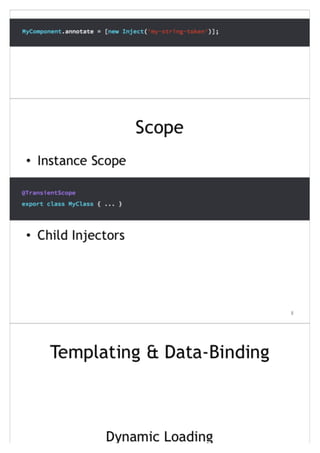
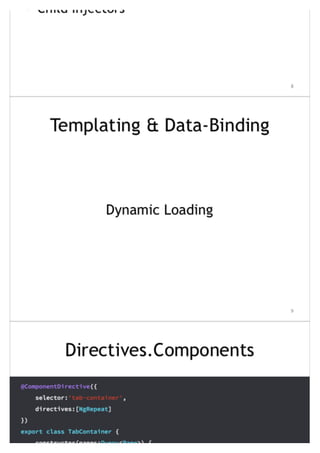
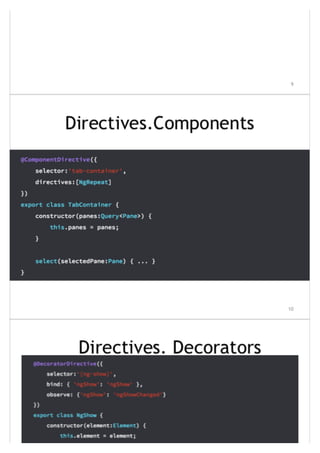
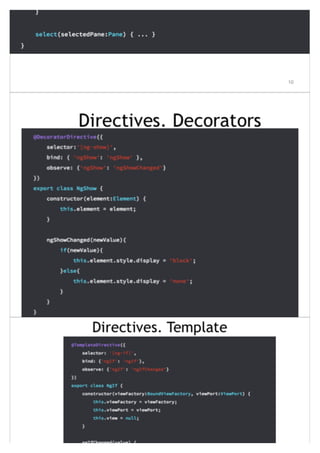

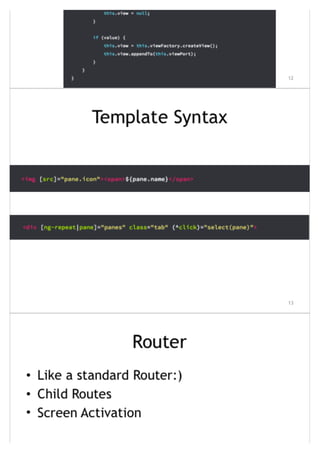



Ad
Recommended
Development Application for Windows 8 by Eugene Kiriyan
Development Application for Windows 8 by Eugene KiriyanDima Maleev
╠²
This document provides an overview of Windows 8 Metro apps. It discusses the prerequisites for developing Metro apps, the available programming languages and technologies, the app sandbox model, capability declarations, contracts and extensions, the application lifecycle, app packages and deployment, file access and permissions, the Windows Store, and takes questions. It is intended as an introductory guide for developers interested in creating Metro apps for Windows 8.Modern mobile development overview
Modern mobile development overviewDima Maleev
╠²
The document provides an overview of modern mobile development platforms, trends, and specifics. It discusses the history and major players in mobile development, including Java ME, Symbian, BlackBerry, iOS, and Android. It analyzes the advantages and disadvantages of each platform and provides recommendations on platform selection and development strategies. Key trends mentioned include cross-platform development, mobile advertising, and integration with cloud services.Lviv .Net User Group. NHibernate
Lviv .Net User Group. NHibernateDima Maleev
╠²
NHibernate is an object-relational mapper (ORM) that allows developers to work with objects in code while NHibernate handles the conversion between objects and relational data. The presentation covers what NHibernate is, why it is useful, and how to use it. Key concepts discussed include the unit of work pattern implemented through ISession, mapping objects to tables, querying with HQL and criteria, and lazy loading of related data. The presenter demonstrates NHibernate through code examples and encourages attendees to follow his blog for more information..NET MicroFramework by Yulian Slobodyan
.NET MicroFramework by Yulian SlobodyanDima Maleev
╠²
The document discusses .NET Micro Framework (MF), an unobtrusive introduction to developing for low-cost embedded devices using .NET and C#. It outlines key trends in internet of things, .NET MF hardware requirements and architecture, and how to get started using development boards and software like Visual Studio 2010. Examples of development boards that can be used include the Netduino and GHI Electronics FEZ Panda II.Mobile for JS Developer
Mobile for JS DeveloperDima Maleev
╠²
This document discusses mobile development platforms for JavaScript developers and provides links to code examples using various frameworks. It mentions trying different approaches and sometimes getting unsatisfactory results. Links are included to CodePen demonstrations of building mobile user interfaces using frameworks like Famo.us that use JavaScript for cross-platform development.Mems
MemsDima Maleev
╠²
ąöąŠą║čāą╝ąĄąĮčé čüąŠą┤ąĄčƹȹĖčé čĆčÅą┤ ąĖčüč鹊čĆąĖą╣ ąĖ ąĮą░čĆčĆą░čéąĖą▓ąŠą▓, ą║ąŠč鹊čĆčŗąĄ ą▓ą░čĆčīąĖčĆčāčÄčéčüčÅ ąŠčé čüą╝ąĄčłąĮčŗčģ ą┤ąŠ ą│čĆčāčüčéąĮčŗčģ, čüą▓čÅąĘą░ąĮąĮčŗčģ čü ą┐čĆąŠčåąĄčüčüąŠą╝ ą┐ąŠą╗čāč湥ąĮąĖčÅ ą│čĆąĖąĮ-ą║ą░čĆčéčŗ ąĖ ą┐čĆąŠč乥čüčüąĖąŠąĮą░ą╗čīąĮčŗą╝ čĆąŠčüč鹊ą╝. ą×ąĮ ąŠčģą▓ą░čéčŗą▓ą░ąĄčé č鹥ą╝čŗ ąĖąĮč鹥čĆą▓čīčÄ, čĆčŗąĮą║ą░ čéčĆčāą┤ą░, čüčéą░čĆčéą░ą┐ąŠą▓, ąŠą▒ą╝ą░ąĮą░ ąĖ ą╝ą░čĆą║ąĄčéąĖąĮą│ą░, ą░ čéą░ą║ąČąĄ ą▓ą║ą╗čÄčćą░ąĄčé čĆą░ąĘą╝čŗčłą╗ąĄąĮąĖčÅ ąŠ čåąĄąĮąĮąŠčüčéąĖ ąŠą▒čĆą░ąĘąŠą▓ą░ąĮąĖčÅ ąĖ ą┐čĆąĖąĮčÅčéąĖčÅ čĆąĄčłąĄąĮąĖą╣ ąŠ ą┐ąĄčĆąĄąĄąĘą┤ąĄ. ąĪčéąĖą╗čī ąĖąĘą╗ąŠąČąĄąĮąĖčÅ ą┐čĆąĄą┤ą┐ąŠą╗ą░ą│ą░ąĄčé čüąŠč湥čéą░ąĮąĖąĄ čÄą╝ąŠčĆą░ ąĖ ą╗ąĖčćąĮąŠą│ąŠ ąŠą┐čŗčéą░.JavaScript in Mobile Development
JavaScript in Mobile DevelopmentDima Maleev
╠²
This document discusses the history and evolution of JavaScript development for mobile applications. It describes how mobile web development began and was followed by the creation of PhoneGap, which allowed JavaScript to be used within native apps. Frameworks like Angular and React Native then emerged to improve on previous approaches and allow JavaScript to be used across mobile platforms in a native-like way. The document questions where this evolution may lead next.Fear and Loathing at PhoneGap
Fear and Loathing at PhoneGapDima Maleev
╠²
A developer has been struggling with PhoneGap for two years, finding that projects always end up poorly. While technology itself is good, the developer's experience with PhoneGap has been frustrating. The document provides advice on developing mobile apps directly instead of using PhoneGap, including using Sublime Text with plugins for editing, compiling from the terminal or an IDE, and debugging techniques.Development Applications for Chrome OS
Development Applications for Chrome OSDima Maleev
╠²
This document discusses developing apps for Chrome OS and describes the different types of apps that can be built, including Chrome Apps, Chrome Packaged Apps, and Native Clients. It outlines the app lifecycle and key parts like the manifest and background scripts. Native Clients are recommended for resource-intensive apps like 3D games, multimedia editors, CAD modeling, data analytics, and simulations.Gamification
GamificationDima Maleev
╠²
The document discusses gamification, which is defined as using game design techniques, game thinking, and game mechanics to enhance non-game contexts. It provides examples of key elements used in gamification including mechanics, dynamics, aesthetics, and story. Specific mechanics discussed include levels, points, combos, and epicness. The document also notes that gamification works because our brain likes rewards, solving problems, and surprises.Go mobile with Windows Phone
Go mobile with Windows PhoneDima Maleev
╠²
Windows Phone 7 introduced a new "Metro" interface that focused on the end user experience. It featured a 1 GHz processor, multi-touch screen, sensors like accelerometers and GPS, and the ability to develop applications using Silverlight or XNA. The Windows Phone marketplace allowed developers to distribute apps and games through a centralized storefront. Overall, Windows Phone 7 marked a significant change from older Windows Mobile platforms and aimed to make the user interface and development experience more cohesive.Time. To manage, or not to manage
Time. To manage, or not to manageDima Maleev
╠²
The document discusses time management techniques for increasing efficiency. It describes an experiment with four stages: preparation, input data collection during a normal work week, implementation of time management techniques, and results. Specific techniques discussed include setting weekly goals and tasks lists, prioritizing tasks using an ABC approach, and scheduling meetings and events on a calendar. The author provides contact information and recommends a self-analysis tool to help with time management and productivity.Parallel extensions in .Net 4.0
Parallel extensions in .Net 4.0Dima Maleev
╠²
The document discusses parallel extensions in .NET 4.0, including an overview of parallel loops, tasks, PLINQ, and coordination data structures (CDS). It notes that parallelism relies on increasing CPU core counts rather than frequency. Parallel loops, tasks, and PLINQ allow exploiting multi-core systems. Tasks control work using a task scheduler and thread pool. PLINQ parallelizes LINQ queries. CDS like concurrent collections help synchronize concurrent tasks. Examples demonstrate parallel algorithms and performance analysis tools.ąĪąŠąĘą┤ą░ąĮąĖąĄ SharePoint 2010 čĆąĄčłąĄąĮąĖą╣ ą▓ Visual Studio
ąĪąŠąĘą┤ą░ąĮąĖąĄ SharePoint 2010 čĆąĄčłąĄąĮąĖą╣ ą▓ Visual StudioDima Maleev
╠²
ąöąŠą║čāą╝ąĄąĮčé čĆą░čüčüą╝ą░čéčĆąĖą▓ą░ąĄčé čĆą░ąĘčĆą░ą▒ąŠčéą║čā čĆąĄčłąĄąĮąĖą╣ ąĮą░ ą┐ą╗ą░čéč乊čĆą╝ąĄ SharePoint 2010 čü ąĖčüą┐ąŠą╗čīąĘąŠą▓ą░ąĮąĖąĄą╝ Visual Studio. ą×ą┐ąĖčüą░ąĮąĖąĄ ąŠčģą▓ą░čéčŗą▓ą░ąĄčé čĆą░ąĘą╗ąĖčćąĮčŗąĄ ą░čüą┐ąĄą║čéčŗ, čéą░ą║ąĖąĄ ą║ą░ą║ ą┐ąŠą╗čīąĘąŠą▓ą░č鹥ą╗čīčüą║ąĖą╣ ąĖąĮč鹥čĆč乥ą╣čü, ąĖąĮč鹥ą│čĆą░čåąĖčÄ čü ą▓ąĄą▒-čüą╗čāąČą▒ą░ą╝ąĖ, čĆą░ą▒ąŠčéčā čü ą┤ą░ąĮąĮčŗą╝ąĖ ąĖ ąĮąŠą▓čłąĄčüčéą▓ą░ ą▓ čĆą░ą▒ąŠčćąĖčģ ą┐čĆąŠčåąĄčüčüą░čģ. ąóą░ą║ąČąĄ čāą┐ąŠą╝ąĖąĮą░čÄčéčüčÅ ąĖąĮčüčéčĆčāą╝ąĄąĮčéčŗ ąĖ ą▓ąŠąĘą╝ąŠąČąĮąŠčüčéąĖ, ą┤ąŠčüčéčāą┐ąĮčŗąĄ ą┤ą╗čÅ čĆą░ąĘčĆą░ą▒ąŠčéčćąĖą║ąŠą▓, ą▓ą║ą╗čÄčćą░čÅ čüčĆąĄą┤čüčéą▓ą░ čĆą░ąĘčĆą░ą▒ąŠčéą║ąĖ ąĖ ą┐ąŠą┤ą┤ąĄčƹȹ║čā ą┐ą░ą║ąĄč鹊ą▓.24000 Days Of UX
24000 Days Of UXDima Maleev
╠²
Vasyl Mylko presented on 24,000 days of UX experience. He discussed the evolution of user experience from early concepts like the memex in 1945 to modern interfaces on mobile devices. He analyzed how top mobile devices adhere to Hick's law and Fitts' law, which relate user interaction time to the number of choices and size/distance of targets. While the iPhone revolutionized mobile UX, he found it no longer a killer experience and was surprised Google Nexus One didn't breakthrough. He believes the next phase of UX will involve nanotechnology and interaction with architectures.Developing silverlight applications for windows phone 7 series
Developing silverlight applications for windows phone 7 seriesDima Maleev
╠²
This document provides an overview and agenda for a presentation on developing Silverlight applications for Windows Phone 7 using Visual Studio 2010. The presentation includes:
1. A brief history of Windows Mobile systems and an introduction to the new features of Windows Phone 7, including the Metro UI, hubs, and the Windows Phone Marketplace.
2. An overview of the Windows Phone 7 application platform, including the Silverlight and XNA frameworks, Visual Studio and Expression Blend tools, and cloud services.
3. A "Hello World" demo and discussion of developing applications using Silverlight with Windows Phone 7.
4. A question and answer session and information on resources for Windows Phone 7 development.New Features Of ASP.Net 4 0
New Features Of ASP.Net 4 0Dima Maleev
╠²
The document outlines the key changes and new features in ASP.Net 4.0, including improvements to core services, Web Forms, and Visual Studio 2010 Web Designer. It discusses enhancements such as view state improvements, routing support, browser capabilities updates, and the addition of over 200 HTML and JScript code snippets. The presentation agenda and references provide additional resources for learning more about ASP.Net 4.0.Microsoft Azure
Microsoft AzureDima Maleev
╠²
Microsoft Azure is a cloud computing platform that provides computing and data services. It includes Windows Azure for running applications, SQL Azure for cloud-based data services based on SQL Server, and App Fabric for distributed infrastructure services. Windows Azure provides a Windows environment for applications and storage in Microsoft data centers. SQL Azure offers data services based on SQL Server in the cloud. App Fabric provides distributed services to both cloud and local applications.Wenn alles versagt - IBM Tape sch├╝tzt, was z├żhlt! Und besonders mit dem neust...
Wenn alles versagt - IBM Tape sch├╝tzt, was z├żhlt! Und besonders mit dem neust...Josef Weingand
╠²
IBM LTO10AI VIDEO MAGAZINE - June 2025 - r/aivideo
AI VIDEO MAGAZINE - June 2025 - r/aivideo1pcity Studios, Inc
╠²
AI VIDEO MAGAZINE - r/aivideo community newsletter ŌĆō Exclusive Tutorials: How to make an AI VIDEO from scratch, PLUS: How to make AI MUSIC, Hottest ai videos of 2025, Exclusive Interviews, New Tools, Previews, and MORE - JUNE 2025 ISSUE -ŌĆ£Key Requirements to Successfully Implement Generative AI in Edge DevicesŌĆöOpt...
ŌĆ£Key Requirements to Successfully Implement Generative AI in Edge DevicesŌĆöOpt...Edge AI and Vision Alliance
╠²
For the full video of this presentation, please visit: https://www.edge-ai-vision.com/2025/06/key-requirements-to-successfully-implement-generative-ai-in-edge-devices-optimized-mapping-to-the-enhanced-npx6-neural-processing-unit-ip-a-presentation-from-synopsys/
Gordon Cooper, Principal Product Manager at Synopsys, presents the ŌĆ£Key Requirements to Successfully Implement Generative AI in Edge DevicesŌĆöOptimized Mapping to the Enhanced NPX6 Neural Processing Unit IPŌĆØ tutorial at the May 2025 Embedded Vision Summit.
In this talk, Cooper discusses emerging trends in generative AI for edge devices and the key role of transformer-based neural networks. He reviews the distinct attributes of transformers, their advantages over conventional convolutional neural networks and how they enable generative AI.
Cooper then covers key requirements that must be met for neural processing units (NPU) to support transformers and generative AI in edge device applications. He uses transformer-based generative AI examples to illustrate the efficient mapping of these workloads onto the enhanced Synopsys ARC NPX NPU IP family.Using the SQLExecutor for Data Quality Management: aka One man's love for the...
Using the SQLExecutor for Data Quality Management: aka One man's love for the...Safe Software
╠²
The SQLExecutor is one of FMEŌĆÖs most powerful and flexible transformers. Pivvot maintains a robust internal metadata hierarchy used to support ingestion and curation of thousands of external data sources that must be managed for quality before entering our platform. By using the SQLExecutor, Pivvot can efficiently detect problems and perform analysis before data is extracted from our staging environment, removing the need for rollbacks or cycles waisted on a failed job. This presentation will walk through three distinct examples of how Pivvot uses the SQLExecutor to engage its metadata hierarchy and integrate with its Data Quality Management workflows efficiently and within the source postgres database. Spatial Validation ŌĆōValidating spatial prerequisites before entering a production environment. Reference Data Validation - Dynamically validate domain-ed columns across any table and multiple columns per table. Practical De-duplication - Removing identical or near-identical well point locations from two distinct source datasets in the same table.cnc-processing-centers-centateq-p-110-en.pdf
cnc-processing-centers-centateq-p-110-en.pdfAmirStern2
╠²
ū×ū©ūøū¢ ūóūÖūæūĢūōūÖūØ ū¬ūóū®ūÖūÖū¬ūÖ ūæūóū£ 3/4/5 ū”ūÖū©ūÖūØ, ūóūō 22 ūöūŚū£ūżūĢū¬ ūøū£ūÖūØ ūóūØ ūøū£ ūÉūżū®ū©ūĢūÖūĢū¬ ūöūóūÖūæūĢūō ūöūōū©ūĢū®ūĢū¬.╠²ūæūóū£ ū®ūśūŚ ūóūæūĢūōūö ūÆūōūĢū£ ūĢū×ūŚū®ūæ ūĀūĢūŚ ūĢū¦ū£ ū£ūöūżūóū£ūö ūæū®ūżūö ūöūóūæū©ūÖū¬/ū©ūĢūĪūÖū¬/ūÉūĀūÆū£ūÖū¬/ūĪūżū©ūōūÖū¬/ūóū©ūæūÖū¬ ūĢūóūĢūō..
ū×ūĪūĢūÆū£ ū£ūæū”ūó ūżūóūĢū£ūĢū¬ ūóūÖūæūĢūō ū®ūĢūĀūĢū¬ ūöū×ū¬ūÉūÖū×ūĢū¬ ū£ūóūĀūżūÖūØ ū®ūĢūĀūÖūØ: ū¦ūÖūōūĢūŚ ūÉūĀūøūÖ, ūÉūĢūżū¦ūÖ, ūĀūÖūĪūĢū©, ūĢūøū©ūĪūĢūØ ūÉūĀūøūÖ.10 Key Challenges for AI within the EU Data Protection Framework.pdf
10 Key Challenges for AI within the EU Data Protection Framework.pdfPriyanka Aash
╠²
10 Key Challenges for AI within the EU Data Protection Framework2025_06_18 - OpenMetadata Community Meeting.pdf
2025_06_18 - OpenMetadata Community Meeting.pdfOpenMetadata
╠²
The community meetup was held Wednesday June 18, 2025 @ 9:00 AM PST.
Catch the next OpenMetadata Community Meetup @ https://www.meetup.com/openmetadata-meetup-group/
In this month's OpenMetadata Community Meetup, "Enforcing Quality & SLAs with OpenMetadata Data Contracts," we covered data contracts, why they matter, and how to implement them in OpenMetadata to increase the quality of your data assets!
Agenda Highlights:
¤æŗ Introducing Data Contracts: An agreement between data producers and consumers
¤ōØ Data Contracts key components: Understanding a contract and its purpose
¤¦æŌĆŹ¤Ä© Writing your first contract: How to create your own contracts in OpenMetadata
¤”Š An OpenMetadata MCP Server update!
Ō×Ģ And More!OpenPOWER Foundation & Open-Source Core Innovations
OpenPOWER Foundation & Open-Source Core InnovationsIBM
╠²
penPOWER offers a fully open, royalty-free CPU architecture for custom chip design.
It enables both lightweight FPGA cores (like Microwatt) and high-performance processors (like POWER10).
Developers have full access to source code, specs, and tools for end-to-end chip creation.
It supports AI, HPC, cloud, and embedded workloads with proven performance.
Backed by a global community, it fosters innovation, education, and collaboration.Securing Account Lifecycles in the Age of Deepfakes.pptx
Securing Account Lifecycles in the Age of Deepfakes.pptxFIDO Alliance
╠²
Securing Account Lifecycles in the Age of DeepfakesYou are not excused! How to avoid security blind spots on the way to production
You are not excused! How to avoid security blind spots on the way to productionMichele Leroux Bustamante
╠²
We live in an ever evolving landscape for cyber threats creating security risk for your production systems. Mitigating these risks requires participation throughout all stages from development through production delivery - and by every role including architects, developers QA and DevOps engineers, product owners and leadership. No one is excused! This session will cover examples of common mistakes or missed opportunities that can lead to vulnerabilities in production - and ways to do better throughout the development lifecycle.More Related Content
More from Dima Maleev (10)
Development Applications for Chrome OS
Development Applications for Chrome OSDima Maleev
╠²
This document discusses developing apps for Chrome OS and describes the different types of apps that can be built, including Chrome Apps, Chrome Packaged Apps, and Native Clients. It outlines the app lifecycle and key parts like the manifest and background scripts. Native Clients are recommended for resource-intensive apps like 3D games, multimedia editors, CAD modeling, data analytics, and simulations.Gamification
GamificationDima Maleev
╠²
The document discusses gamification, which is defined as using game design techniques, game thinking, and game mechanics to enhance non-game contexts. It provides examples of key elements used in gamification including mechanics, dynamics, aesthetics, and story. Specific mechanics discussed include levels, points, combos, and epicness. The document also notes that gamification works because our brain likes rewards, solving problems, and surprises.Go mobile with Windows Phone
Go mobile with Windows PhoneDima Maleev
╠²
Windows Phone 7 introduced a new "Metro" interface that focused on the end user experience. It featured a 1 GHz processor, multi-touch screen, sensors like accelerometers and GPS, and the ability to develop applications using Silverlight or XNA. The Windows Phone marketplace allowed developers to distribute apps and games through a centralized storefront. Overall, Windows Phone 7 marked a significant change from older Windows Mobile platforms and aimed to make the user interface and development experience more cohesive.Time. To manage, or not to manage
Time. To manage, or not to manageDima Maleev
╠²
The document discusses time management techniques for increasing efficiency. It describes an experiment with four stages: preparation, input data collection during a normal work week, implementation of time management techniques, and results. Specific techniques discussed include setting weekly goals and tasks lists, prioritizing tasks using an ABC approach, and scheduling meetings and events on a calendar. The author provides contact information and recommends a self-analysis tool to help with time management and productivity.Parallel extensions in .Net 4.0
Parallel extensions in .Net 4.0Dima Maleev
╠²
The document discusses parallel extensions in .NET 4.0, including an overview of parallel loops, tasks, PLINQ, and coordination data structures (CDS). It notes that parallelism relies on increasing CPU core counts rather than frequency. Parallel loops, tasks, and PLINQ allow exploiting multi-core systems. Tasks control work using a task scheduler and thread pool. PLINQ parallelizes LINQ queries. CDS like concurrent collections help synchronize concurrent tasks. Examples demonstrate parallel algorithms and performance analysis tools.ąĪąŠąĘą┤ą░ąĮąĖąĄ SharePoint 2010 čĆąĄčłąĄąĮąĖą╣ ą▓ Visual Studio
ąĪąŠąĘą┤ą░ąĮąĖąĄ SharePoint 2010 čĆąĄčłąĄąĮąĖą╣ ą▓ Visual StudioDima Maleev
╠²
ąöąŠą║čāą╝ąĄąĮčé čĆą░čüčüą╝ą░čéčĆąĖą▓ą░ąĄčé čĆą░ąĘčĆą░ą▒ąŠčéą║čā čĆąĄčłąĄąĮąĖą╣ ąĮą░ ą┐ą╗ą░čéč乊čĆą╝ąĄ SharePoint 2010 čü ąĖčüą┐ąŠą╗čīąĘąŠą▓ą░ąĮąĖąĄą╝ Visual Studio. ą×ą┐ąĖčüą░ąĮąĖąĄ ąŠčģą▓ą░čéčŗą▓ą░ąĄčé čĆą░ąĘą╗ąĖčćąĮčŗąĄ ą░čüą┐ąĄą║čéčŗ, čéą░ą║ąĖąĄ ą║ą░ą║ ą┐ąŠą╗čīąĘąŠą▓ą░č鹥ą╗čīčüą║ąĖą╣ ąĖąĮč鹥čĆč乥ą╣čü, ąĖąĮč鹥ą│čĆą░čåąĖčÄ čü ą▓ąĄą▒-čüą╗čāąČą▒ą░ą╝ąĖ, čĆą░ą▒ąŠčéčā čü ą┤ą░ąĮąĮčŗą╝ąĖ ąĖ ąĮąŠą▓čłąĄčüčéą▓ą░ ą▓ čĆą░ą▒ąŠčćąĖčģ ą┐čĆąŠčåąĄčüčüą░čģ. ąóą░ą║ąČąĄ čāą┐ąŠą╝ąĖąĮą░čÄčéčüčÅ ąĖąĮčüčéčĆčāą╝ąĄąĮčéčŗ ąĖ ą▓ąŠąĘą╝ąŠąČąĮąŠčüčéąĖ, ą┤ąŠčüčéčāą┐ąĮčŗąĄ ą┤ą╗čÅ čĆą░ąĘčĆą░ą▒ąŠčéčćąĖą║ąŠą▓, ą▓ą║ą╗čÄčćą░čÅ čüčĆąĄą┤čüčéą▓ą░ čĆą░ąĘčĆą░ą▒ąŠčéą║ąĖ ąĖ ą┐ąŠą┤ą┤ąĄčƹȹ║čā ą┐ą░ą║ąĄč鹊ą▓.24000 Days Of UX
24000 Days Of UXDima Maleev
╠²
Vasyl Mylko presented on 24,000 days of UX experience. He discussed the evolution of user experience from early concepts like the memex in 1945 to modern interfaces on mobile devices. He analyzed how top mobile devices adhere to Hick's law and Fitts' law, which relate user interaction time to the number of choices and size/distance of targets. While the iPhone revolutionized mobile UX, he found it no longer a killer experience and was surprised Google Nexus One didn't breakthrough. He believes the next phase of UX will involve nanotechnology and interaction with architectures.Developing silverlight applications for windows phone 7 series
Developing silverlight applications for windows phone 7 seriesDima Maleev
╠²
This document provides an overview and agenda for a presentation on developing Silverlight applications for Windows Phone 7 using Visual Studio 2010. The presentation includes:
1. A brief history of Windows Mobile systems and an introduction to the new features of Windows Phone 7, including the Metro UI, hubs, and the Windows Phone Marketplace.
2. An overview of the Windows Phone 7 application platform, including the Silverlight and XNA frameworks, Visual Studio and Expression Blend tools, and cloud services.
3. A "Hello World" demo and discussion of developing applications using Silverlight with Windows Phone 7.
4. A question and answer session and information on resources for Windows Phone 7 development.New Features Of ASP.Net 4 0
New Features Of ASP.Net 4 0Dima Maleev
╠²
The document outlines the key changes and new features in ASP.Net 4.0, including improvements to core services, Web Forms, and Visual Studio 2010 Web Designer. It discusses enhancements such as view state improvements, routing support, browser capabilities updates, and the addition of over 200 HTML and JScript code snippets. The presentation agenda and references provide additional resources for learning more about ASP.Net 4.0.Microsoft Azure
Microsoft AzureDima Maleev
╠²
Microsoft Azure is a cloud computing platform that provides computing and data services. It includes Windows Azure for running applications, SQL Azure for cloud-based data services based on SQL Server, and App Fabric for distributed infrastructure services. Windows Azure provides a Windows environment for applications and storage in Microsoft data centers. SQL Azure offers data services based on SQL Server in the cloud. App Fabric provides distributed services to both cloud and local applications.Recently uploaded (20)
Wenn alles versagt - IBM Tape sch├╝tzt, was z├żhlt! Und besonders mit dem neust...
Wenn alles versagt - IBM Tape sch├╝tzt, was z├żhlt! Und besonders mit dem neust...Josef Weingand
╠²
IBM LTO10AI VIDEO MAGAZINE - June 2025 - r/aivideo
AI VIDEO MAGAZINE - June 2025 - r/aivideo1pcity Studios, Inc
╠²
AI VIDEO MAGAZINE - r/aivideo community newsletter ŌĆō Exclusive Tutorials: How to make an AI VIDEO from scratch, PLUS: How to make AI MUSIC, Hottest ai videos of 2025, Exclusive Interviews, New Tools, Previews, and MORE - JUNE 2025 ISSUE -ŌĆ£Key Requirements to Successfully Implement Generative AI in Edge DevicesŌĆöOpt...
ŌĆ£Key Requirements to Successfully Implement Generative AI in Edge DevicesŌĆöOpt...Edge AI and Vision Alliance
╠²
For the full video of this presentation, please visit: https://www.edge-ai-vision.com/2025/06/key-requirements-to-successfully-implement-generative-ai-in-edge-devices-optimized-mapping-to-the-enhanced-npx6-neural-processing-unit-ip-a-presentation-from-synopsys/
Gordon Cooper, Principal Product Manager at Synopsys, presents the ŌĆ£Key Requirements to Successfully Implement Generative AI in Edge DevicesŌĆöOptimized Mapping to the Enhanced NPX6 Neural Processing Unit IPŌĆØ tutorial at the May 2025 Embedded Vision Summit.
In this talk, Cooper discusses emerging trends in generative AI for edge devices and the key role of transformer-based neural networks. He reviews the distinct attributes of transformers, their advantages over conventional convolutional neural networks and how they enable generative AI.
Cooper then covers key requirements that must be met for neural processing units (NPU) to support transformers and generative AI in edge device applications. He uses transformer-based generative AI examples to illustrate the efficient mapping of these workloads onto the enhanced Synopsys ARC NPX NPU IP family.Using the SQLExecutor for Data Quality Management: aka One man's love for the...
Using the SQLExecutor for Data Quality Management: aka One man's love for the...Safe Software
╠²
The SQLExecutor is one of FMEŌĆÖs most powerful and flexible transformers. Pivvot maintains a robust internal metadata hierarchy used to support ingestion and curation of thousands of external data sources that must be managed for quality before entering our platform. By using the SQLExecutor, Pivvot can efficiently detect problems and perform analysis before data is extracted from our staging environment, removing the need for rollbacks or cycles waisted on a failed job. This presentation will walk through three distinct examples of how Pivvot uses the SQLExecutor to engage its metadata hierarchy and integrate with its Data Quality Management workflows efficiently and within the source postgres database. Spatial Validation ŌĆōValidating spatial prerequisites before entering a production environment. Reference Data Validation - Dynamically validate domain-ed columns across any table and multiple columns per table. Practical De-duplication - Removing identical or near-identical well point locations from two distinct source datasets in the same table.cnc-processing-centers-centateq-p-110-en.pdf
cnc-processing-centers-centateq-p-110-en.pdfAmirStern2
╠²
ū×ū©ūøū¢ ūóūÖūæūĢūōūÖūØ ū¬ūóū®ūÖūÖū¬ūÖ ūæūóū£ 3/4/5 ū”ūÖū©ūÖūØ, ūóūō 22 ūöūŚū£ūżūĢū¬ ūøū£ūÖūØ ūóūØ ūøū£ ūÉūżū®ū©ūĢūÖūĢū¬ ūöūóūÖūæūĢūō ūöūōū©ūĢū®ūĢū¬.╠²ūæūóū£ ū®ūśūŚ ūóūæūĢūōūö ūÆūōūĢū£ ūĢū×ūŚū®ūæ ūĀūĢūŚ ūĢū¦ū£ ū£ūöūżūóū£ūö ūæū®ūżūö ūöūóūæū©ūÖū¬/ū©ūĢūĪūÖū¬/ūÉūĀūÆū£ūÖū¬/ūĪūżū©ūōūÖū¬/ūóū©ūæūÖū¬ ūĢūóūĢūō..
ū×ūĪūĢūÆū£ ū£ūæū”ūó ūżūóūĢū£ūĢū¬ ūóūÖūæūĢūō ū®ūĢūĀūĢū¬ ūöū×ū¬ūÉūÖū×ūĢū¬ ū£ūóūĀūżūÖūØ ū®ūĢūĀūÖūØ: ū¦ūÖūōūĢūŚ ūÉūĀūøūÖ, ūÉūĢūżū¦ūÖ, ūĀūÖūĪūĢū©, ūĢūøū©ūĪūĢūØ ūÉūĀūøūÖ.10 Key Challenges for AI within the EU Data Protection Framework.pdf
10 Key Challenges for AI within the EU Data Protection Framework.pdfPriyanka Aash
╠²
10 Key Challenges for AI within the EU Data Protection Framework2025_06_18 - OpenMetadata Community Meeting.pdf
2025_06_18 - OpenMetadata Community Meeting.pdfOpenMetadata
╠²
The community meetup was held Wednesday June 18, 2025 @ 9:00 AM PST.
Catch the next OpenMetadata Community Meetup @ https://www.meetup.com/openmetadata-meetup-group/
In this month's OpenMetadata Community Meetup, "Enforcing Quality & SLAs with OpenMetadata Data Contracts," we covered data contracts, why they matter, and how to implement them in OpenMetadata to increase the quality of your data assets!
Agenda Highlights:
¤æŗ Introducing Data Contracts: An agreement between data producers and consumers
¤ōØ Data Contracts key components: Understanding a contract and its purpose
¤¦æŌĆŹ¤Ä© Writing your first contract: How to create your own contracts in OpenMetadata
¤”Š An OpenMetadata MCP Server update!
Ō×Ģ And More!OpenPOWER Foundation & Open-Source Core Innovations
OpenPOWER Foundation & Open-Source Core InnovationsIBM
╠²
penPOWER offers a fully open, royalty-free CPU architecture for custom chip design.
It enables both lightweight FPGA cores (like Microwatt) and high-performance processors (like POWER10).
Developers have full access to source code, specs, and tools for end-to-end chip creation.
It supports AI, HPC, cloud, and embedded workloads with proven performance.
Backed by a global community, it fosters innovation, education, and collaboration.Securing Account Lifecycles in the Age of Deepfakes.pptx
Securing Account Lifecycles in the Age of Deepfakes.pptxFIDO Alliance
╠²
Securing Account Lifecycles in the Age of DeepfakesYou are not excused! How to avoid security blind spots on the way to production
You are not excused! How to avoid security blind spots on the way to productionMichele Leroux Bustamante
╠²
We live in an ever evolving landscape for cyber threats creating security risk for your production systems. Mitigating these risks requires participation throughout all stages from development through production delivery - and by every role including architects, developers QA and DevOps engineers, product owners and leadership. No one is excused! This session will cover examples of common mistakes or missed opportunities that can lead to vulnerabilities in production - and ways to do better throughout the development lifecycle."How to survive Black Friday: preparing e-commerce for a peak season", Yurii ...
"How to survive Black Friday: preparing e-commerce for a peak season", Yurii ...Fwdays
╠²
We will explore how e-commerce projects prepare for the busiest time of the year, which key aspects to focus on, and what to expect. WeŌĆÖll share our experience in setting up auto-scaling, load balancing, and discuss the loads that Silpo handles, as well as the solutions that help us navigate this season without failures.AI vs Human Writing: Can You Tell the Difference?
AI vs Human Writing: Can You Tell the Difference?Shashi Sathyanarayana, Ph.D
╠²
This slide illustrates a side-by-side comparison between human-written, AI-written, and ambiguous content. It highlights subtle cues that help readers assess authenticity, raising essential questions about the future of communication, trust, and thought leadership in the age of generative AI.Enhance GitHub Copilot using MCP - Enterprise version.pdf
Enhance GitHub Copilot using MCP - Enterprise version.pdfNilesh Gule
╠²
║▌║▌▀Ż deck related to the GitHub Copilot Bootcamp in Melbourne on 17 June 2025Connecting Data and Intelligence: The Role of FME in Machine Learning
Connecting Data and Intelligence: The Role of FME in Machine LearningSafe Software
╠²
In this presentation, we want to explore powerful data integration and preparation for Machine Learning. FME is known for its ability to manipulate and transform geospatial data, connecting diverse data sources into efficient and automated workflows. By integrating FME with Machine Learning techniques, it is possible to transform raw data into valuable insights faster and more accurately, enabling intelligent analysis and data-driven decision making.Creating Inclusive Digital Learning with AI: A Smarter, Fairer Future
Creating Inclusive Digital Learning with AI: A Smarter, Fairer FutureImpelsys Inc.
╠²
Have you ever struggled to read a tiny label on a medicine box or tried to navigate a confusing website? Now imagine if every learning experience felt that wayŌĆöevery single day.
For millions of people living with disabilities, poorly designed content isnŌĆÖt just frustrating. ItŌĆÖs a barrier to growth. Inclusive learning is about fixing that. And today, AI is helping us build digital learning thatŌĆÖs smarter, kinder, and accessible to everyone.
Accessible learning increases engagement, retention, performance, and inclusivity for everyone. Inclusive design is simply better design.Raman Bhaumik - Passionate Tech Enthusiast
Raman Bhaumik - Passionate Tech EnthusiastRaman Bhaumik
╠²
A Junior Software Developer with a flair for innovation, Raman Bhaumik excels in delivering scalable web solutions. With three years of experience and a solid foundation in Java, Python, JavaScript, and SQL, she has streamlined task tracking by 20% and improved application stability.FIDO Seminar: Evolving Landscape of Post-Quantum Cryptography.pptx
FIDO Seminar: Evolving Landscape of Post-Quantum Cryptography.pptxFIDO Alliance
╠²
FIDO Seminar: Evolving Landscape of Post-Quantum CryptographyŌĆ£Key Requirements to Successfully Implement Generative AI in Edge DevicesŌĆöOpt...
ŌĆ£Key Requirements to Successfully Implement Generative AI in Edge DevicesŌĆöOpt...Edge AI and Vision Alliance
╠²
You are not excused! How to avoid security blind spots on the way to production
You are not excused! How to avoid security blind spots on the way to productionMichele Leroux Bustamante
╠²
Ad
